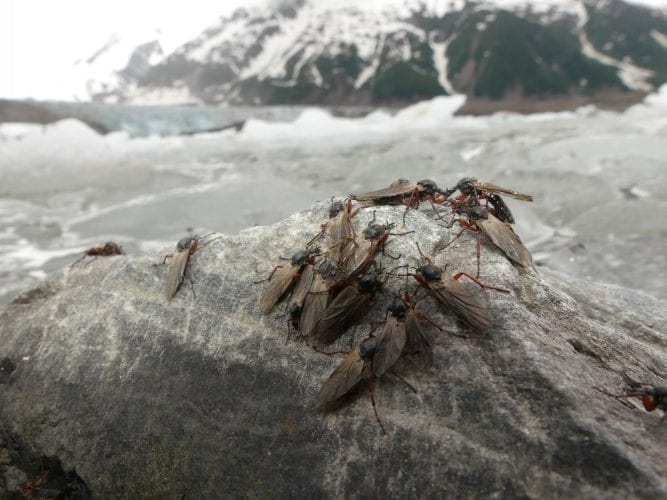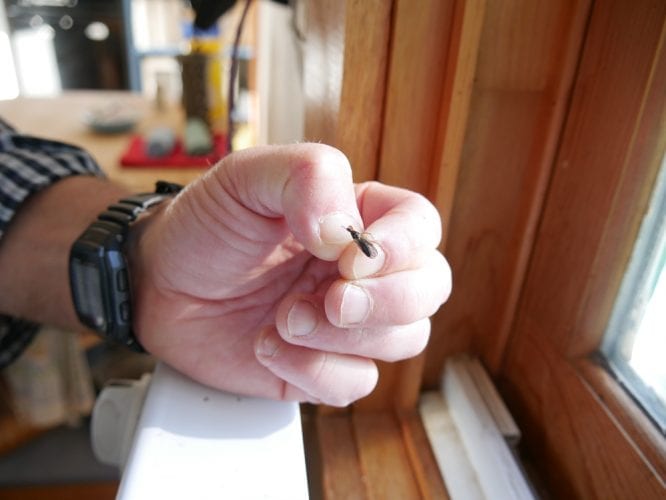The end of last month saw large numbers of flies swarming in Petersburg and had people speculating about the cause of the sudden influx. It appears the insects were March flies and occasionally emerge in these big swarms. One bug enthusiast says they’re likely around in other years but aren’t as noticeable in smaller concentrations.
Audio PlayerThe flies were hard to miss, the last week in May, bumping into bikers and walkers and getting stuck on car windshields but not biting. They flew erratically, slowly and were easy to capture. I corralled one outside KFSK, took some photos and sent out some inquiries.
John Hudson of Juneau responded with a definitive ID – March flies.
“They are quite unique and different from other families of flies,” Hudson said. “March flies are in the family of flies called bibionidae which I love the way it rolls off the tongue and probably so named March flies because whomever identified them or noticed them first saw them coming out in March wherever they lived in the world. But here in Alaska I’ve noticed and in your case as well it seems like late May and in your case as well it seems like late May and in June is when they emerge.”
Hudson is a former U.S. Fish and Wildlife Service biologist who now works for the Southeast Alaska Watershed Coalition. As a biologist he specialized in fisheries and aquatic ecology but he considers himself an amateur entomologist, someone who studies insects. Hudson has authored several books on dragonflies and aquatic insects.
Juneau had its own experience with swarms of the insects in 2012. And at this stage in their life cycle, they are emerging as adults to mate.
“When they emerge and they do so in mass, in mass numbers, and probably to avoid intense predation they just come off out of the ground in huge numbers, they’re doing so to swarm,” Hudson explained. “These are mating swarms that people are seeing.”
One species of March fly in North America is called the love bug because males and females can stay connected while mating for days at a time. Like other insects, or like salmon for that matter, the flies mate and then die off soon after. But the flies begin their lives from eggs laid in the soil. They hatch into larvae and survive by eating dead organic matter, like leaves, along with plant roots through the fall and winter. Hudson said along with fungi, bacteria and other invertebrates they’re an important recycler of that organic material. And after these flies emerge, mate and die, they become an important food source for birds in the spring.
“It’s just wonderful to think about that cycle of life from say alder leaves falling off the trees onto the ground, the March fly larvae consuming those leaves, emerging eventually in the spring as adults and the after mating becoming a wonderful food source for migratory birds like warblers and things like that,” he said.
Hudson suspects the flies emerge in Southeast every spring, but not always in such noticeably large numbers. He did come across a localized emergence while on a rafting trip down the Tatshenshini River a year ago.

March flies congregate on rocks and ice bergs near the Walker Glacier in Glacier Bay National Park in June 2017. (Photo courtesy of John Hudson)
“And we stopped at Walker Glacier which is a very kind of famous glacier to stop at on that rafting trip and walked over to the glacier and there had been a mass emergence of March flies,” Hudson said. “We’d seen them during the days previous floating down the river and then we came upon this amazing density of them. And they were so thick along the margins of the lake. They covered rocks and they were actually thickly congregated on ice bergs which made for an interesting sight to see all these lethargic half frozen insects.”
Hudson said temperature and weather conditions likely influence how many of the flies survive the Southeast Alaska winter and also trigger these springtime mating swarms. He speculates that conditions were just right in Petersburg this winter and Juneau six years ago that large numbers survived to adulthood. But in adulthood they don’t eat and die soon after mating, so just weeks later they’re long gone.












